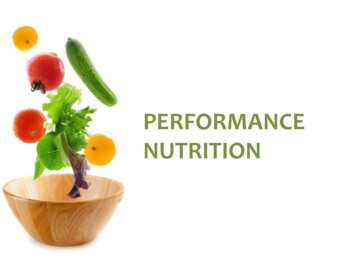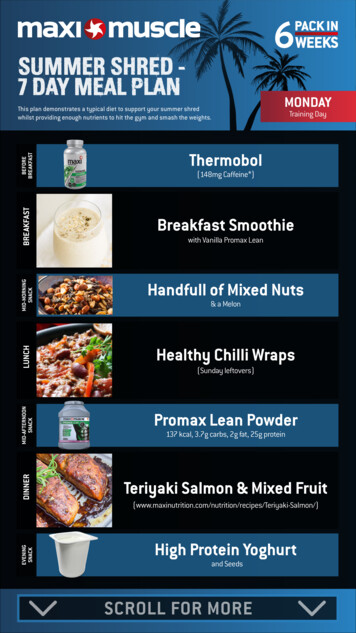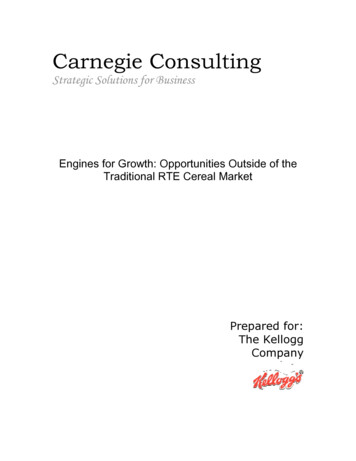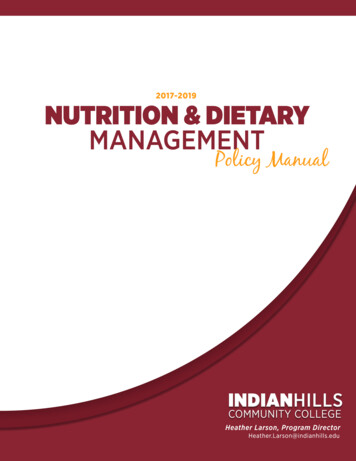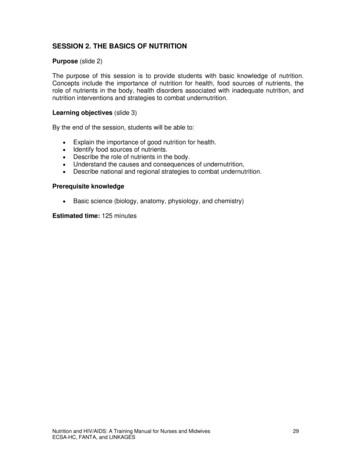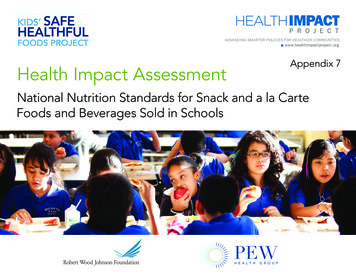
Transcription
Health Impact AssessmentAppendix 7National Nutrition Standards for Snack and a la CarteFoods and Beverages Sold in Schools
Appendix 7: Summary of Literature of Nutrition Policy and/or Program ImpactsThis appendix summarizes literature that evaluates impacts from implementing competitive food nutrition policies or programs.Each research article was scored according to the guidelines in Appendix 2. Briefly, a score of “1” is considered weak, “2” is consideredfair, and “3” or higher is considered strong. The results of the literature are provided here based on how they affect a specific outcomesuch that:( ) indicates general positive impact on an outcome(-) indicates general negative impact on an outcome(0) indicates no impact( /0 or -/0) indicates inconsistent findingsTable A8.1: Survey of literature showing impacts on access to healthy and unhealthy itemsCitation/ScoreYvonne M. Terry-McElrath et al.,“The School Food Environmentand Student Body Mass Index andFood Consumption: 2004 to 2007National Data,” Journal of AdolescentHealth 45, suppl. 3 (2009): S45–56.(Fair)PolicyDistrict wellness policies between2004 and 2007PopulationNational sample, MS andHS students in theYouth, Education, andSociety (YES) andMonitoring the Future(MTF) studiesHealthy(0/ ) No change in fruitand vegetable offeringsL. A. Lytle et al., “InfluencingHealthful Food Choices in Schooland Home Environments: Resultsfrom the TEENS Study,” PreventiveMedicine 43, no. 1 (2006): 8–13.Multicomponent intervention,including promoting and offering100% fruit juice, water, low-fat milk,fruit and vegetables, and lower-fatoptions; limiting higher-fat a la carteoptions and snacks with more than 5 gof fat, as well as fruit drinks16 middle schools, TwinCities MN; 1997–2000;this research is part ofthe TEEN Study, arandomized, controlledschool based interventionover 2-years( ) Compared to controlschools, interventionschools offered (P 0.04)and sold (P 0.07) ahigher proportion ofhealthier foods a la carte.Multicomponent intervention20 secondary schools, St.( ) At study end, 42% ofandUnhealthyReduced the availabilityof regular sugar/fat fooditems in competitivefood outletsL. A. Lytle et al., “School-BasedApproaches to Affect Adolescents‘Diets: Results From the TEENSStudy,” Health Education & Behav31, no. 2 (2004): 270–87. (Strong)S. A. French et al., “An1
Citation/ScoreEnvironmental Intervention toPromote Lower-Fat Food Choicesin Secondary Schools: Outcomes ofthe TACOS Study,” AmericanJournal of Public Health 94 (2004):1507–12. (Strong)Policyincreasing availability of lower-fat(snacks 5 g or less per serving) foodsserved a la carte and school-widestudent promotions of these lower-fatfoodsPopulationPaul, MN; TACOS; 2year group; randomizedcontrolKaren Weber Cullen, Kathy Watson,and Issa Zakeri, “Improvements inMiddle School Student DietaryIntake After Implementation of theTexas Public School NutritionPolicy,” American Journal of PublicHealth 98, no. 1 (2004): 111–17.(Fair)Policy in all competitive food outlets;for middle schools, the policy restrictsthe portion sizes of high-fat and -sugarsnacks (limits vary by food group),sweetened beverages ( 12 oz), and thefat content of all foods served ( 28 gfat per serving no more than 2 timesper week); it also sets limits on thefrequency of serving high-fatvegetables, such as french fries (3 ozper serving no more than 3 times perweek)A la carte/snack bar goals reduce allregular chips serving size bags to 1.5oz, increase lower-fat chip offerings by25%; offer bottled water in a 20 ozsize; and limit all sweetened beveragesto 12 oz.3 MS in TX; 2001–02,2002–03, 2005–06;repeated measures;longitudinal; naturalexperiment2 schools in pilot in eachCA, NC, TX; 2004;cross-sectional part ofbaseline( ) Offered fruits andvegetables; all schoolschanged water and SSBserving sizes; 5 of 6schools changed low-fatchip goalCT standards: Low-fat (1%) milk anddairy alternatives: 32 g total sugar per 8oz, no artificial sweeteners; 35% totalcalories from fat and 10% caloriesfrom saturated fat per serving. Fruit orvegetable juice (100%) and water: noadded sugar, artificial sweeteners orcaffeine. Portion sizes: all drinks 12oz (except water without added juice).Snacks and desserts: 35% totalcalories from fat and 7 g per serving(with the exception of nuts, seeds,CT; 8 schools (3 ES, 4MS, 1 HS); 2003–05; 3year intervention pilot( ) 5 of 8 schools followedstandards in year 2 (onlysold water, milk, 100%fruit juice, replacedsnacks); students in allschools reported morewater consumption;general increases in healthyfood consumption acrossfood types; No changesyear 1; 2 schools hadincreased NSLPJill Hartstein et al., “Impact ofPortion-size Control for School áLa Carte Items: Changes inKilocalories and MacronutrientsPurchased by Middle SchoolStudents,” Journal of the AmericanDietetic Association 108, no. 1 (2008):140–44. (Weak/Fair)G. Dowaliby et al., Connecticut’s HealthySnack Pilot Case Studies(Middletown, CT: ConnecticutState Department of Education,Bureau of Health and NutritionServices and Child/Family/SchoolPartnerships, 2007).andG. Dowailiby et al., Connecticut’sHealthy Snack Pilot Summary DataHealthythe a la carte foods werelower fat (an increase of51%) in interventionschools, compared with28% of the a la carte foods(a decrease of 5%) incontrol schools.( /-) Beverage contractsspecific 12 oz size; snackmachine inventoriesadhered to policy andmachines were off duringlunch; 1% milk served, 5different fruits andvegetables (not countingpotatoes) served in a lacarteUnhealthySnack bar provided moreunhealthy items; vendingmachines provided lessin year 3 than in year 1.Children brought moreSSBs, desserts, candy,and snack chips fromhome.( /-) In 5 schools, fewerstudents reportedconsumption of SSBs; in3 schools, more studentsreported SSBconsumption (nostatistics).2
Citation/ScoreReport. (Middletown: CT:Connecticut State Department ofEducation, Bureau of Health andNutrition Services andChild/Family/School Partnerships,2007). (Weak/Fair)Michael W. Long, Kathryn E.Henderson, and Marlene B.Schwartz, “Evaluating the Impactof a Connecticut Program toReduce Availability of UnhealthyCompetitive Food in Schools,”Journal of School Health 80, no. 10(2010): 478–86. (Fair)Sarah E. Samuels et al., “TheCalifornia Endowment’s HealthyEating, Active CommunitiesProgram: A Midpoint Review,”American Journal of Public Health 100(2010): 2114–23.andSarah E. Samuels et al., HealthyEating, Active Communities Phase 1Evaluation Findings 2005–2008(Oakland, CA: Samuels andAssociates, 2009). (Weak)Policypeanut and other nut butters, andcheeses). Sat. fat and trans fat: 10%of calories from saturated fat and/ortrans fat and 2 g per serving. Addedsugar: 35% by weight and 15 g perserving. For low-fat smoothies, yogurt,and pudding: no more than 5 g totalsugar per ounce. Snacks may notcontain artificial sweeteners. Wholegrain foods, FV available.Connecticut Healthy FoodCertification Nutrition standards: fat: 35% calories, 7 g package; sat fat: 10% calories, 2 g package; trans fat:0 g; sugar: 35% and 15 g perpackage; sodium: 500 mg ( 230 mgsnacks, 480 mg dairy); soups: 7 gfat per serving, sat. fat 2 g perserving, trans fat 0 g, sugar 15 g perserving, sodium 1000mgPopulationHealthyparticipation when healthyitems offered.UnhealthyRepeated measures;cross-sectional survey;151 school districts; CTImplementation of SB 12 (foods).Allowed to sell seeds, nuts, butters,low-fat dairy individual items. Snackitems 250 kcal total; 35% caloriesfrom fat, 10% total calories from sat.fat; 35% total weight from sugar.Dairy and whole grain products meet35/10/35, and have 175 calories.Entrees must have 35% of caloriesfrom fat, 400 kcal max.SB 965 (drinks): 50–100% fruit andvegetable drinks with no addedsweeteners, water with no addedsweeteners, milk and dairy alternatives 2% fat, 28 g total sugars, 8 oz sportsdrinks with no caffeine, 42 g addedsweetener per 20 oz in MS/HS6 MS in CA; 2005 and2008; multicomponentintervention, includingwellness policy changesfrom state bills, HEAC( ) On average, all CT districts reduced availability ofunhealthy competitive foods. On average, all districtsreported a reduction in the number of unhealthy a lacarte snack categories offered from the baseline year toyear 1, F(1,71) 41.127, F(1,68) 61.390, and F(1,64) 89.310, for elementary, middle, and high schools,respectively, p .001 for all levels. However, HFCparticipation was related to a significantly greaterdecline in unhealthy categories offered in elementaryand high schools, F(1,71) 4.642, p .035 and F(1,64) 7.338, p .009, respectively. Middle schools showeda trend in this same direction, F(1,68) 2.919, p .09.A comparison betweenbaselineand midpoint data showsthat the HEAC schools’adherence to competitivebeverage standardsincreased from 45% to78% between 2005 and2008, and the adherence tocompetitive food standardsincreased from 23% to67%.3
Citation/ScoreAnastasia M. Snelling and TehaKennard, “The Impact ofNutrition Standards onCompetitive Food Offerings andPurchasing Behaviors of HighSchool Students,” Journal of SchoolHealth 79, no. 11 (2009): 541–46.(Weak)PolicyPolicy in 2006: Beverages: water, milk(1% or skim), juices containing at least25% juice ( 12 oz); Snacks: 300calories/item, 30% of total caloriesfrom fat, except seeds/nuts; 10% oftotal calories from sat. fat; sugar 35%by weight, whole grain breads andcereals offered, portion sizes 1.25 ozfor snacks and sweets, 2 oz forcookies, 3 oz for bakery items andfrozen desserts, 8 oz for yogurt, lowsodiumGail Woodward-Lopez et al. “LessonsLearned from Evaluations ofCalifornia’s Statewide SchoolNutrition Standards,” AmericanJournal of Public Health 100, no. 11(2010): 2137–45. (Fair/Strong)Implementation of SB 12 (foods).Allowed to sell seeds, nuts, butters,low-fat dairy individual items. Snackitems 250 kcal total; 35% caloriesfrom fat, 10% total calories from sat.fat; 35% total weight from sugar.Dairy and whole grain products meet35/10/35, and are 175 calories.Entrees must have 35% of caloriesfrom fat, and be 400 kcal. SB 965Drinks: 50–100% fruit and vegetabledrinks, no added sweeteners; water, noadded sweeteners; milk and dairyalternatives 2% fat, 28 g total sugars,8 oz sports drinks no caffeine, 42 gadded sweetener per 20 oz in MS/HSPopulation3 public HS, in 1 county;non-experimentallongitudinal study;descriptive info fromfood offerings andpurchases; 2005 and2007; coded foods byStoplight Diet (green low calorie, high nutrient;yellow moderatecalorie, moderatenutrient; red highcalorie, low nutrient)Data from HEAC, HighSchool Study, and SchoolWellness Studies, 2005–08, 2007–08, and 2007–09Healthy( /0) Decreased offeringof unhealthy red items(57% in 2005 to 30% in2007); increasedmoderately healthy yellowfoods (meeting standards)(18% to 48%); decreasedoffering of healthiest greenitems (fruits, vegetables)25% to 22% in 2007.Unhealthy(0/ ) ES/MS: little prelegislation versus postlegislation change in thenumber of food andbeverage items offered. HSreduced the number ofdifferent types of itemsoffered by 25%–35%(beverages) and 10%–15%(food). Unlike foods,nearly all beveragecategories were either100% compliant or 0%compliant.4
Citation/ScoreM. Boles et al., “Changes in LocalSchool Policies and Practices inWashington State After anUnfunded Physical Activity andNutrition Mandate,” PreventingChronic Disease 8 no. 6 (2011): 1–13.(Fair)Policy2005 WA physical activity andnutrition mandate (PAN) impact onMS and HS practicesPopulationPublic health surveillancedata secondary dataanalysis compared WA(with mandate) to ORschools (no mandate),same time periodHealthy( /-) MS and HS had asignificant (18.8–20.0percentage point) increasein the number of schoolswith restricted access tocompetitive foods (whatfoods and time of day). MSincreased type of foodssold (10.4 percentagepoints). Unexpectedly,healthy food options (lowfat snacks, fruits, veggies)for MS/HS declinedsignificantly, by 5.9 and 2.0percentage points,respectively.J. E. Blum et al., “Impact of Maine’sStatewide Nutrition Policy on HighSchool Food Environments,”Preventing Chronic Disease 8 no. 1(2011): 1–10. (Fair)Chapter 51 legislation in Maine 200489 HS, ME; crosssectional surveyElaine S. Belansky et al., “EarlyEffects of the Federally MandatedLocal Wellness Policy on SchoolNutrition Environments AppearModest in Colorado’s Rural, LowIncome Elementary Schools,”Journal of the American DieteticAssociation 110 no. 11 (2010): 1712–17. (Fair)District wellness policies following2004 federal mandate40 school districts in CO;repeated random sample;cross-sectional surveys;2005–07( /0) Availability of sodain student vendingsignificantly decreased pre–Chapter 51 versus post–Chapter 51 (P .04). Nosignificant changes werefound for other SSBs andjunk foods.( /0) Lunchroom: ( )fresh fruits (0.8 choices in2005 to 1.15 choices in2007, p 0.04). Parties:21.4% healthy to 48.7%p 0.04. No changes inveggies in other locations.( ) There were notsignificant healthy foods invending machines.D. R. Taber et al., “Banning AllState policies governing the sale ofBridging the Gap,UnhealthyImplementation of a completeban—no change in offerings.These schools may havebeen eliminating thesevenues for foodpurchases rather thanreducing the availabilityof healthier food types invending machines orschool stores. Anotherexplanation for thedecline may be changingperceptions of schoolprincipals about whatconstitutes a “healthy”option.( ) Fewer students5
Citation/ScoreSugar-sweetened Beverages inMiddle Schools: Reduction of Inschool Access and Purchasing butNot Overall Consumption,”Archives of Pediatrics & AdolescentMedicine 166, no.3 (2012): 256-62.(Fair).Janet M. Wojcicki and Melvin B.Heyman, “Healthier Choices andIncreased Participation in a MiddleSchool Lunch Program: Effects ofNutrition Policy Changes in SanFrancisco,” American Journal of PublicHealth 96, no. 9 (2006): 1542–47.(Fair/Strong)Nicole Larson and Mary Story, “Are‘Competitive Foods’ Sold at SchoolMaking Our Children Fat?” HealthAffairs (Project Hope) 29, no. 3(2010): 430–35. (Strong)P. C. Jaime and K. Lock, “Do SchoolBased Food and Nutrition PoliciesImprove Diet and ReducePolicysoda and other SSBs in middle schoolsin 2006–07. States were classified ashaving (1) policy limiting theavailability of soda and other SSBs(e.g., “Only milk, water, and 100%juice will be available in school”); (2)policy prohibiting soda but no policylimiting the availability of other SSBs(e.g., “Allowed beverages include milk,water, energy drinks, and electrolytereplacement beverages”); or (3) nopolicy limiting any type of SSBWater: no added sweeteners; juice andjuice blends: 12 oz max, no addedsweeteners, no caffeine or herbalsupplements; milk or dairy substitute:1% or fat-free, 1.4 oz (40 g) sugar per12 oz, 12 oz; food: 30% cal fat, 10% cal sat. fat plus trans-fat, 35%sugar by weight; snacks must includeno less than 5% of 8 nutrients; portionsize limits 1.25 oz chips, crackers,popcorn, cereal, jerky; 2.5 oz trail mix,nuts, seeds, dried fruit; 2 ozcookies/cereal bars; 3 oz bakery items;3 fl oz frozen desserts; 8 fl oz nonfrozen yogurt; 12 oz limit for allbeverages except water; fruits andveggies sold at all sites; warning labelson peanut foodsReviewPopulationBRFSS, Early ChildhoodLongitudinal StudyKindergarten Cohort;1998–2007; nationalsample; correlationvarianceHealthyreported in-school accessin states that banned allSSBs (prevalencedifference, 14.9; 95% CI, 23.6 to 6.1, p 0.0001);no access differencesbetween states banningonly soda and thoseallowing all SSBsUnhealthySan Francisco UnifiedSchool District (SFUSD);surveys; 1 class per gradelevel in schools 500; 2classes per grade level inschools 500–1,200; 3classes per grade level inschools 1,200( )Beginning in August2003, all SFUSD schoolsaltered their snack barmenus to meet the reviseddistrict-wide nutritionstandards., phased outsoda, Twinkies, Slim Jims,and giant pizzas, andreplaced them withhealthier items such assushi, fresh soup, delisandwiches, 100% fruitjuice, baked chicken withrice, etc.U.S. school-based studiesthrough 2009With few exceptions, cross-sectional (and longitudinalstudies have found that students have better dietsrelative to the recommendations of the 2005 DietaryGuidelines for Americans when unhealthy competitivefoods are not sold at school.ReviewSchool-based nutritionpolicy studies, earliestrecord to 20074 studies on the impact of guidelines on foodavailability, focused primarily on fruit and vegetablesoffered at school lunch (could be a la carte). All6
Citation/ScoreObesity?” Preventive Medicine 48, no.1 (2008): 45–53. (Strong)PolicyPopulationHealthyUnhealthystudies showed that guidelines led to increased fruitand vegetable availability, [ranging from 0.28servings/day to 0.48 servings/day].7
Table A8.2 Survey of literature on student purchases and/or general food intakeCitation/ScorePolicy or InterventionPopulation, DesignImpact—Healthy ItemsImpact—Unhealthyor OverallOverall calorie intakethe same betweenintervention andcontrolGary D. Foster et al., “A Policy-basedSchool Intervention to PreventOverweight and Obesity,” Pediatrics121, no. 4 (2008): e794–802. (Fair)Beverages: 100% juice (6 oz servingsize), water (no portion limits), andlow-fat milk (8 oz serving size);Snacks: allowed 7 g total fat, 2 g sat.fat, 360 mg sodium, and 15 g sugarper serving4–6 grade; 10 schools;1,349 students; midAtlantic region; 2-yearmatched randomizedcontrol; repeatedmeasures(0) Fruit and vegetableintake the same betweenintervention and controlJames F. Sallis et al., “EnvironmentalInterventions for Eating andPhysical Activity: a RandomizedControlled Trial in MiddleSchools,” American Journal ofPreventive Medicine 24, no. 3 (2003):209–17.(Strong)Multicomponent intervention toprovide and market low-fat foods atall school food sources included tastetests and new foods in menus.24 MS; randomizedcontrolled trial; SanDiego CA(0) Introduction of newitems was limited; nosignificant changes inpurchase or consumptionL. A. Lytle et al., “InfluencingHealthful Food Choices in Schooland Home Environments: Resultsfrom the TEENS Study,” PreventiveMedicine 43, no. 1 (2006): 8–13.(Strong)Multicomponent intervention,including promoting and offering100% fruit juice, water, low-fat milk,fruit and vegetables, and lower-fatoptions; limiting higher fat a la carteoptions and snacks with more than 5g fat and fruit drinks16 MS, Twin Cities, MN;1997–2000; Teens Eatingfor Energy and NutritionSchools (TEENS)(0) No effects were seen forfruit and vegetables sales aspart of the regular mealpattern lunch.Dianne Neumark-Sztainer et al.,“School Lunch and SnackingPatterns Among High SchoolStudents: Associations with SchoolFood Environment and Policies,”International Journal of BehavioralNutrition and Physical Activity 2, no. 1(2005): 14. (Fair)Nutrition intervention, looked atexposure to vending machines20 HS, Minneapolis, St.Paul; TACOS study; 2year group; randomizedintervention by school;cross-sectional surveysand observations( ) Student snack food purchases from vendingmachines were significantly more frequent amongstudents from schools with a greater number ofsnack food vending machines (1–2 machines, 0.8snack food purchases). Student soft drink purchasesfrom vending machines were not significantlyassociated with the number of soft drink vendingmachines, but were significantly lower in schools inwhich machines were turned off during lunchtime.In schools with policies about the types of foodssold in vending machines, students reported making8
Citation/ScorePolicy or InterventionPopulation, DesignImpact—Healthy ItemsY. Terry-McElrath et al., “The SchoolFood Environment and StudentBody Mass Index and FoodConsumption: 2004 to 2007National Data,” Journal of AdolescentHealth 3, suppl. 1 (2009): 45–56.(Fair)District wellness policies between2004 and 2007National sample; MS andHS students in YES andMTF studiesKaren Weber Cullen, Kathy Watson,and Issa Zakeri, “Improvements inMiddle School Student DietaryIntake After Implementation of theTexas Public School NutritionPolicy,” American Journal of PublicHealth 98, no. 1 (2008): 111–17.(Fair)TX policy in all competitive foodoutlets; for MS, the policy restricts theportion sizes of high-fat and -sugarsnacks (limits vary by food group),sweetened beverages ( 12 oz), andthe fat content of all foods served( 28 g fat per serving no more than 2times per week). It also sets limits onthe frequency of serving high-fatvegetables such as french fries (3 ozper serving no more than 3 times perweek).TX policy (implemented 2004)restricts the portion sizes of high-fatand -sugar snacks to 200 kcal perserving package and sweetenedbeverages to 12 oz, limits the fatcontent of milk offered to 1%,provides guidelines for the fat contentof foods served, and sets limits on the3 MS; TX; 2001–02,2002–03, 2005–06;repeated measures;longitudinal; naturalexperiment( MS/0 HS) MS—odds ofdaily or almost daily fruitintake were significantlyassociated with how oftenschools reported offeringfruits and vegetables;students ate more greenvegetables if offered atlunch or if offered low-fatfood items; no relationshipsin HS( ) More milk andvegetables and fewersweetened beverages, softdrinks, and snack chipswere consumed in year 3than during years 1 and 2.After we controlled forenergy intake, dessert foodservings were significantlylower in year 3 comparedwith year 1.Karen W. Cullen and Kathleen B.Watson, “The Impact of the TexasPublic School Nutrition Policy onStudent Food Selection and Sales inTexas,” American Journal of PublicHealth 99, no. 4 (2009): 706–12.(Fair)2004–05 evaluation toassess policy adherence,daily production recordsfor 23 schools in 5districts sent adequatedata for food availabilitybefore and afterimplementation.,Impact—Unhealthyor Overallsnack food purchases an average of 0.5 days/week ascompared to an average of 0.9 days/week in schoolswithout policies. Similar non-significant trends werefound for soft drink purchases.Students ate fruit lessfrequently whenschools had regularsugar/fat food itemsin competitive foodoutlets; no HSrelationships( /0) Regardless of district and school size,cafeterias served significantly fewer high-fatvegetable items per student post policy (P .001).Post-policy snack bar sales of large bags of chipswere significantly reduced (P .006), and bakedchips sales significantly increased (P .048). Also,primary school served more portions of fruit perstudent both school years than secondary schools (by9
Citation/ScoreG. Dowaliby et al., Connecticut’s HealthySnack Pilot Case Studies (Middletown,CT: Connecticut State Departmentof Education, Bureau of Health andNutrition Services andChild/Family/School Partnerships,2007). (Weak/Fair)Simone A. French et al., “AnEnvironmental Intervention toPromote Lower-fat Food Choicesin Secondary Schools: Outcomes ofthe TACOS Study,” AmericanJournal of Public Health 94, no 9(2004): 1507–12. (Strong)Anastasia M. Snelling and TehaKennard, “The Impact of NutritionPolicy or InterventionPopulation, Designfrequency of serving high-fatvegetables such as french friespre/post cross-sectionalstudyLow-fat (1%) milk and dairyalternatives: 32 g total sugar per 8 oz,no artificial sweeteners, 35% totalcalories from fat and 10% caloriesfrom saturated fat per serving. Fruitor vegetable juice (100%) and water:no added sugar, artificial sweeteners,or caffeine. Portion sizes: all drinks 12 oz (except water without addedjuice). Snacks and desserts: 35%total calories from fat and 7 g perserving (with the exception of nuts,seeds, peanut and other nut butters,and cheeses). Saturated fat and transfat: 10% of calories from saturatedfat and/or trans fat and 2 g perserving. Added sugar: 35% byweight and 15 g per serving. Forlow-fat smoothies, yogurt, andpudding, no more than 5 g total sugarper ounce. Snacks may not containartificial sweeteners. Whole grainfoods, FV available.Multicomponent interventionincreasing availability of lower fat(Snacks 5 g per serving) foods in a lacarte and school-wide studentpromotions of these lower-fat foodsCT; 8 schools (3 ES, 4MS, 1 HS); 2003–2005; 3year intervention pilotPolicy in 2006 Beverages: water, milk(1% or skim), juices containing at least3 public HS, outsidesingle metro county; non-20 secondary schools, St.Paul MN; TACOS; 2 yearGroup randomizedcontrolImpact—Healthy ItemsImpact—Unhealthyor Overallabout .32 servings). There was no impact on nonfried FV, milk, no changes in drinks or water insnack bars.( 5 schools/0 3 schools) 5schools showed a reductionin child consumption ofregular soft drinks andsweetened tea. Studentspurchased more schoolmeals when only healthysnacks were available.( sales/0 consume) Theintervention schoolsshowed a significantlyhigher mean percentage ofsales of lower-fat foods inyear 1 (27.5% vs. 19.6%, P .096) and a significantlyhigher mean percentage ofsales of lower-fat foods inyear 2 (33.6% vs. 22.1%, P .042)( ) Increased purchase ofgreen foods (11% in 2005No differences instudent reported foodconsumption choicesbetween control andinterventionDecreased purchaseof red foods from10
Citation/ScoreStandards on Competitive FoodOfferings and Purchasing Behaviorsof High School Students,” Journal ofSchool Health 79, no. 11 (2009): 541–6. (Weak)Policy or InterventionPopulation, DesignImpact—Healthy Items25% juice ( 12 oz); Snacks: 300calories/item; 30% of total caloriesfrom fat, except seeds/nuts; 10% oftotal calories from sat. fat; sugar 35% by weight; whole grain breadsand cereals offered; portion sizes 1.25oz for snacks and sweets, 2 oz forcookies, 3 oz for bakery items andfrozen desserts, 8 oz for yogurt; lowsodium.experimental longitudinalstudy; descriptive infofrom food sales; 2005–07; coded foods byStoplight Diet (green low calorie, high nutrient;yellow moderatecalorie, moderate nutrientsuch as those meetingstandards; red highcalorie, low nutrient)Cross-sectional, SNDAIII 2004–05, K–12to 20% in 2007) and yellowfoods (6% in 2005 to 34%in 2007). Studentspurchased the morenutritious yellow and greenfoods when there werefewer red food offerings.R. R. Briefel et al., “School FoodEnvironments and Practices AffectDietary Behaviors of US PublicSchool Children,” Journal ofAmerican Dietetic Association 109, no.2 (2009): S91–S107. (Fair)Impact of exposure to restrictions onlow-nutrient, energy-dense foods(LNED), vending venues, pouringcontractsKaren Weber Cullen and Debbe I.Thompson, “Texas School FoodPolicy Changes Related to MiddleSchool a la Carte/Snack Bar Foods:Potential Savings in Kilocalories.”Journal of the American DieteticAssocation 105 (2005): 1952–54.(Fair)Texas state policy in 2004 impactingthe school competitive venues,including limiting sweetenedbeverages to 12 oz containers andhigh-fat, salty, and sweet foods tosmall, single-serving packages23 MS in TX; crosssectional; used salesrecords to estimate theenergy savings tochildren from policychangesImpact—Unhealthyor Overall83% in 2005 to 46%in 2007. However,even with lowerproportion of redfood offerings (30%in 2007), these foodsmade up almost halfof all competitivefood purchases(47%).( ) Offer daily fresh FV through governmentprogram, reduce 36 kcal from LNED (p .05) in ES.( ) Attending a school without stores or snack barswas estimated to reduce sugar-sweetened beverageconsumption by 22 kcal per school day in MSchildren (P 0.01) and by 28 kcal in HS children(P 0.01).( ) The lack of a pouring rights contract in a schoolreduced SSB consumption by 16 kcal (P 0.05), andno a la carte offerings in a school reducedconsumption by 52 kcal (P 0.001) in MS children.( ) The most effective practices for reducing energyfrom LNED foods were characteristics of the schoolmeal program; not offering french fries reducedLNED foods consumption by 43 kcal in ES children(P 0.01) and SSB consumption by 41 kcal in HSchildren (P 0.001).( ) By reducing portion sizes to smaller, singleserving packages, 47 kcal per student was saved on adaily basis. Over a 180-day school year, an energydeficit equivalent to about 2 lb could occur ifstudents replaced the large portion-sized snacks andbeverages with the smaller sizes on a 1-to-1 basis, didnot buy multiple small bags or small drinks, did notconsume additional other foods or beverages, anddid not change physical activity levels.11
Citation/ScorePolicy or InterventionPopulation, DesignImpact—Healthy ItemsMarlene B. Schwartz, Sarah A.Novak, and Susan S. Fiore, “TheImpact of Removing Snacks ofLow Nutritional Value FromMiddle Schools,” Health Education& Behavior 36, no. 6 (2009): 999–1011. (Fair)Policy: Snacks limited to total fat 35% of calories, saturated fat 10%of calories, added sugar 35% byweight, and limiting serving sizes.Beverages: water, milk, and 100%juice2-year nonrandomintervention; 6intervention schools, 6control; CT; repeatedsurveysJill Hartstein et al., “Impact ofPortion-size Control for School áLa Carte Items: Changes inKilocalories and MacronutrientsPurchased by Middle SchoolStudents,” Journal of the AmericanDietetic Association 108, no. 1 (2008):140–44. (Weak/Fair)Intervention: a la carte/snack bargoals reduce all regular chips servingsize bags to 1.5 oz, increase lowerfat chip offerings by 25%; offerbottled water in a 20 oz size, and limitall sweetened beverages to 12 oz6 schools total: 2 schoolsin pilot in each CA, NC,TX; 2004; cross-sectionalpart of baseline( ) Intervention schoolsincreased consumption ofhealthy drinks from year 1to year 2, comparisonschools had no increase (B .33, p .05); MNSintervention schoolsconsumed more bakedchips, pretzels, popcorn,and crackers; comparisonschools stayed the same (B .29, p .05)( /0) Significant changes inpercent of kilocalories fromprotein (P 0.05) andounces of water (P 0.01),sweetened beverages(P 0.01), and regular chips(P 0.05) were found acrossthe 6 schools. Noincreases in FV purchasesJ.A. Mendoza et al., “Change inDietary Energy Density AfterImplementation of the Texa
100% fruit juice, water, low-fat milk, fruit and vegetables, and lower-fat options; limiting higher-fat a la carte options and snacks with more than 5 g of fat, as well as fruit drinks 16 middle schools, Twin Cities MN; 1997-2000; this research is part of the TEEN Study, a randomized, controlled school based intervention over 2-years
